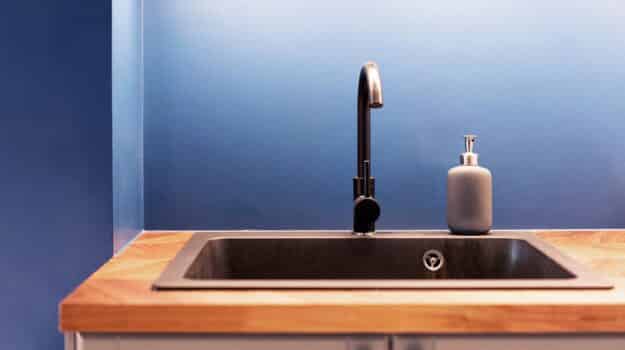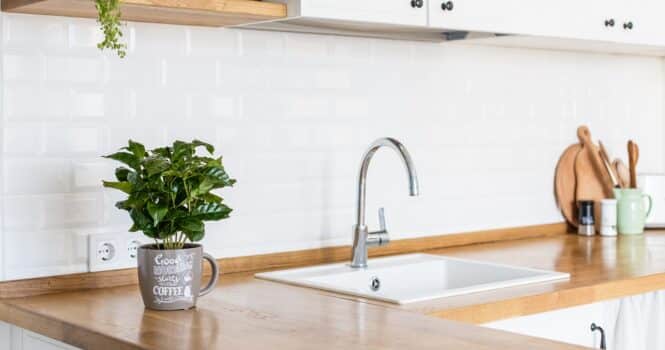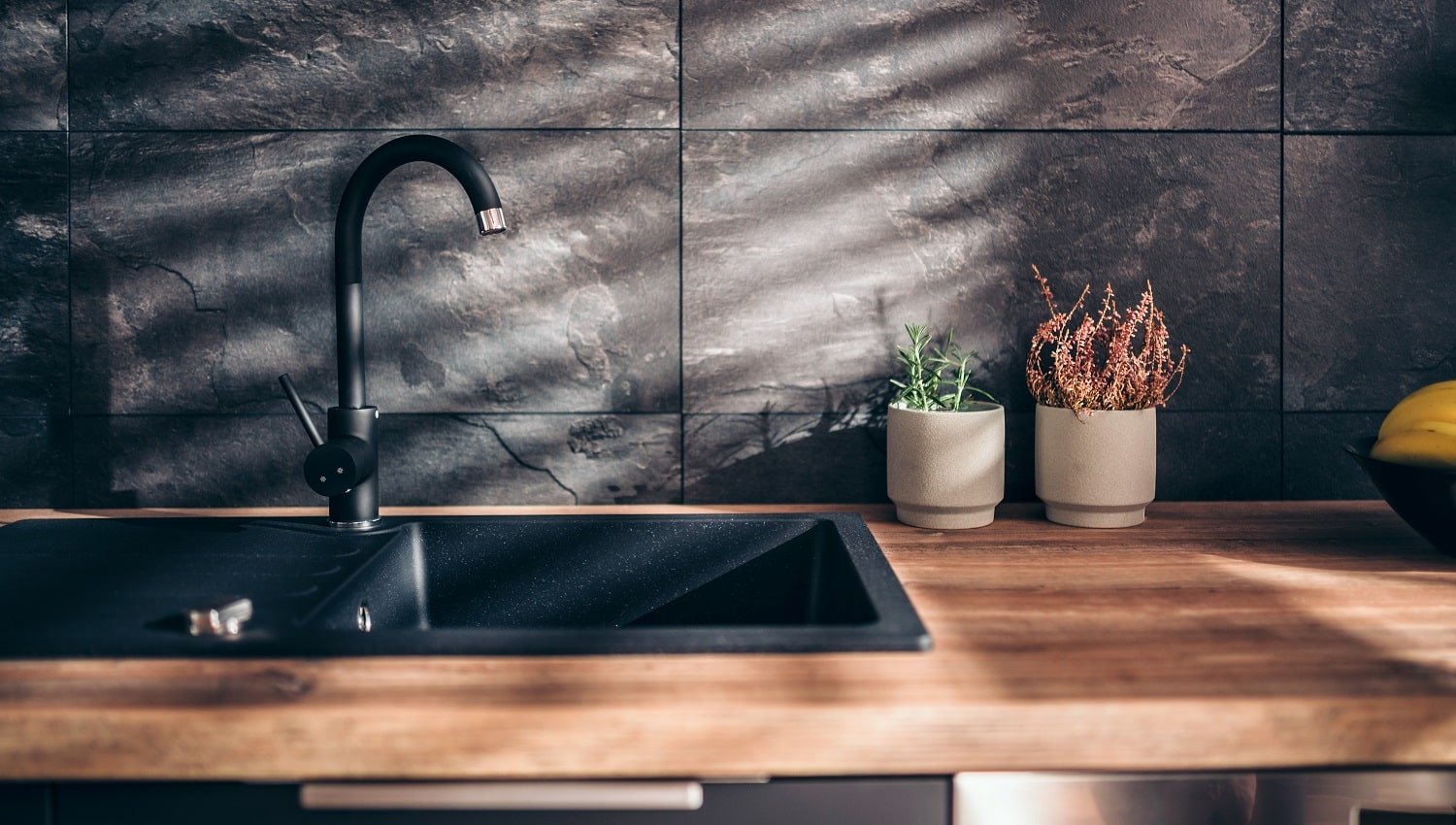Do you have a wooden counter where you would like to install a sink?
Wooden countertops are incredibly pleasing on the eye. They are easy to clean, making them low maintenance; however, you may need to install a sink to complete the setting. Many of you might be worried that water and wood may not mix.
You’re right; they don’t, yet there is a way both can exist in perfect harmony. Your wooden counter must have a waterproof and food-safe finish to ensure installing a sink won’t lead to any untoward incidents. All your items will be safe, while the sink can upgrade the functional value of the countertop.
Therefore, the question is, how do you correctly install the sink without causing any damage to the existing structure? Our carefully researched content will tell you all you need to know to make the right choices.
So, read on to find out.
Things to Remember

Before we get started, you must remember to use adhesive sealants, caulking, and brackets to install the sink and prevent it from moving. If you look from above, after installing it, you shouldn’t be able to see the mounting brackets, and that will prove that you’ve followed all the steps correctly.
Plus, you must seal the area where the sink and counter meet. Doing so with the appropriate caulking procedure will help prevent damage from moisture or leaks. You can use silicone caulking, which acts as an excellent support to the undermount brackets. They are available at any store but they are also called clips, so don’t be confused.
The difference between granite and wood counters is that you’ll need more than brackets to ensure the latter can handle the weight of a large sink. Therefore, follow the seven simple steps listed below to install your undermount sink without any hassle.
Step 1
The first step involves measuring out the area where you plan to have the sink fitted. The support beams should hold the pan in place after you’ve lowered it down into the earmarked area. Hence, cut the wooden planks down to the appropriate size beforehand.
Then measure the distance between the top and bottom of your counter and between the top and bottom of your sink. Here, you’ll have to do a bit of calculation, but don’t worry, we are not exactly adept at the subject either. Simply subtract the second value from the first one to find out the height of the supporting planks.
You can use another technique that involves lifting the sink by holding it securely from top and bottom until it’s entirely in line with the countertop. While you’re keeping it in that position, someone can measure the distance between the floor and the bottom of the sink. You can use any of the two methods based on your convenience, but remember to get it right.
Now, you can cut the planks to the required size. Try to use pine instead of plastic or plywood because it’s more secure and can handle the weight of the sink. Besides, to be safe, cut two planks, and keep one nearby.
Step 2
Next, place the sink on the ground and load your caulking gun with silicone sealant. If you want, you can directly use the sealant from the tube, but using a caulking gun offers more consistency. So, generously apply it around the top edge of the sink, and on the sides that are in contact with the counter.
Even if you apply too much sealant, there’s no need to worry; you can remove it later. Meanwhile, place the sink in such a manner that the rim touches the underside of the countertop hole. Ensure that the sink edges and the top of the countertop are well aligned to make it as flush as possible.
There’s no need to hurry, but make sure you’re thorough and get the job done before the sealant dries.
Step 3
Once you’ve set the sink in one smooth line with the countertop, it’s time to use the planks you had cut out earlier. Go under your sink and use them to hold the sink up by placing them at regular distances. For more reliability, you can have someone hold the sink while you arrange the planks.
The planks must provide a tight fit to exert upward pressure on the sink. The force is essential to help the silicone bond firmly with the countertop. Make sure that the sink has not moved from its place because the silicone is wet, and fixing the planks could alter the alignment.
Execute the necessary adjustments and leave it to dry, based on the time mentioned on the sealant bottle.
Step 4
Once the sealant has dried, it’s time to conduct an examination and see if everything went smoothly. Now, you can remove the excess sealant by using a dull putty knife. Be careful so as not to inflict any damage.
In case some areas are difficult to do away with, you’ll need to take some sandpaper or a small nail file. Then use it to smoothen out the edges and try to cater it according to the finish of your sink for best results. But refrain from scratching or marking the interior.
Step 5
We are nearing the end, and the next step is installing the undermount sink brackets. You need to work from under the sink and mark the spots where you want to fit the brackets. Keep them apart at an even distance from one another for maximum strength and support.
Placing one at each corner usually proves to be sufficient. You must fit the bracket so that one end touches the underside of the wood counter while the other end should be in contact with the bottom of the sink rim.
You’ll have to drill the screws that come with the brackets unto the underside of the silicone caulking to fix it to the surface. Use one-inch screws because they are long enough to hold the structure in place but not so big that they are visible.
Step 6
We have seen that working clockwise is the best. If you have worked on the top right corner first, move on to the bottom right bracket next. It is an effective method to gauge the distance between brackets and to figure out where the next one should go.
Confirm there are no gaps between the sink and the countertop and that everything is tightly in place. Still, you must keep in mind that certain areas could show signs of stress over time, particularly near the faucet and handles.
Step 7
You can use the silicone sealant in these areas and fill up the gaps. Allow it to dry and follow the same procedure of carving off the rough areas to get a smooth surface. As a result, the area will be tightly sealed, thereby preventing the structure from developing leaks.
All said and done, you can then move onto the plumbing part of things after the sealant has dried and the brackets installed. Take care to remove the supporting planks, and your sink will be ready for use.
Maintenance Tips
Regular check-ups can go a long way, and if not, at least you can check whether the brackets are maintaining the tightness.
Even everyday use may lead to one of the screws coming loose, so it never hurts to check. The most important thing you can do is to clean your sink and countertop. Wood counters are sturdier than most structures, but regular maintenance will ensure your sink stays in place.
You may want to avoid leaving heavy dishes or other items in the sink for long periods, which could affect the structure over time. As an undermount sink is primarily suspended from above, putting too much weight on it could directly impact the clips.

Final Words
We hope our guide has cleared some of the doubts you had about installing a sink.
Having gone through our steps, you’ll see it’s not as difficult as it seems. Keep all your components with you a day before installation, and read the steps carefully before starting. It never hurts to double-check whether you have followed the procedure correctly.
Ensure that the sink edge and the counter are perfectly aligned to make one smooth surface. If you’re thorough, you won’t have to worry about moisture or leaks in the future. That’s all from us and we hope you enjoy the sink and countertop for a long time. See you soon!
Related Articles
13 Best Double Bowl Kitchen Sinks
Why Your Water Dispenser Might Leak & How to Fix It?
How Does A Touchless Faucet Work | Expert Talks
13 Best Commercial Kitchen Faucets Right Now
How to Remove a Stuck Faucet Handle
13 Best Kitchen Sink Faucets to Consider | Buyer’s Guide + Reviews
How to Repaint a Fireclay Farmhouse Kitchen Sink
11 Best Bar Stools Today | Buyer’s Guide and Reviews
7 Best Sink Protector Right Now



